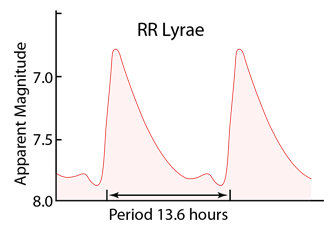RR Lyrae Variables
RR Lyrae variables are periodic variable stars, commonly found in globular clusters. They are used as standard candles to measure (extra)galactic distances, assisting with the cosmic distance ladder. This class is named after the prototype and brightest example, RR Lyrae. They are pulsating horizontal branch stars of spectral class A or F, with a mass of around half the Sun's. They are thought to have shed mass during the red-giant branch phase, and were once stars of similar or slightly less mass than the Sun, around 0.8 solar masses. In contemporary astronomy, a period-luminosity relation makes them good standard candles for relatively nearby targets, especially within the Milky Way and Local Group. They are also frequent objects in the studies of globular clusters and the chemistry (and quantum mechanics) of older stars.(Wikipedia)
 | The prototype star RR Lyrae has a period of 13.6 hours, and short periods of less than a day are characteristic of this class of variable stars. The periods vary within this range, but regardless of the period, they all have absolute magnitudes of approximately 0.0 and can be used as standard candles. Some variations have been seen, but they all seem to fall between 0 and 1 magnitude. |
RR Lyrae stars are metal-poor, population -II stars. Over 80% of the variable stars in globular clusters are RR Lyraes. There are several times as many RR Lyrae variables as all types of Cepheid variables combined. They are found at all galactic latitudes, whereas Cepheids are strongly associated with the galactic plane.

Image modified from Wikipedia, see Reference
RR Lyrae variables are typically found in a particular area of the Hertzsprung-Russell Diagram called the "horizontal branch", and further described as the "RR Lyrae gap" since most of the stars in that area are RR Lyraes.
Star concepts
Reference
RR Lyrae wiki
Pasachoff, Ch. 4.
| HyperPhysics***** Astrophysics | R Nave |